
Saltopus is a genus of very small bipedal dinosauriform containing the single species Saltopus elginensis from the late Triassic period of Scotland. It is one of the most famous Elgin Reptiles.

Plateosaurus is a genus of plateosaurid dinosaur that lived during the Late Triassic period, around 214 to 204 million years ago, in what is now Central and Northern Europe. Plateosaurus is a basal (early) sauropodomorph dinosaur, a so-called "prosauropod". The type species is Plateosaurus trossingensis; before 2019, that honor was given to Plateosaurus engelhardti, but it was ruled as undiagnostic by the ICZN. Currently, there are three valid species; in addition to P. trossingensis, P. longiceps and P. gracilis are also known. However, others have been assigned in the past, and there is no broad consensus on the species taxonomy of plateosaurid dinosaurs. Similarly, there are a plethora of synonyms at the genus level.

Procompsognathus is an extinct genus of coelophysid theropod dinosaur that lived approximately 210 million years ago during the later part of the Triassic Period, in what is now Germany. Procompsognathus was a small-sized, lightly built, ground-dwelling, bipedal carnivore, that could grow up to 1 m (3.3 ft) long.
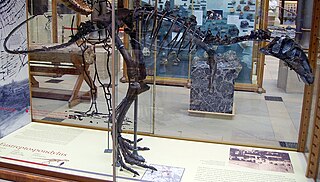
Eustreptospondylus is a genus of megalosaurid theropod dinosaur, from the Oxfordian stage of the Late Jurassic period in southern England, at a time when Europe was a series of scattered islands.

Liliensternus is an extinct genus of basal neotheropod dinosaur that lived approximately 210 million years ago during the latter part of the Triassic Period in what is now Germany. Liliensternus was a moderate-sized, bipedal, ground-dwelling carnivore, that could grow up to 5.15 m (16.9 ft) long. It is the best represented Triassic theropod from Europe and one of the largest known.
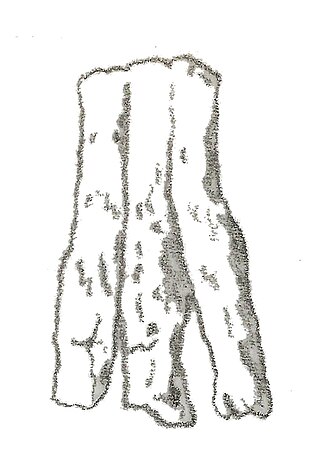
Avipes is a genus of extinct archosaurs represented by the single species Avipes dillstedtianus, which lived during the middle Triassic period. The only known fossil specimen, a partial foot (metatarsals), was found in Bedheim, Thuringia, Germany, in deposits of Lettenkohlensandstein. Avipes was named in 1932 by Huene. Although originally classified as a coelurosaur or a ceratosaur, a new study of the fossil specimen found that it was too incomplete to assign to a group more specific than Archosauria, and so it was regarded as indeterminate by Rauhut and Hungerbuhler in 2000.
Velocipes is a saurischian dinosaur genus from the Late Triassic that may have been a theropod; its fossils were found in the Norian-age Lissauer Breccia of southern Poland.
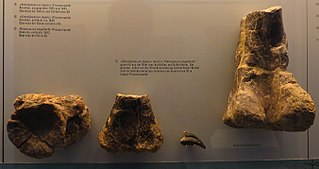
Gresslyosaurus is a genus of plateosaurian sauropodomorph dinosaur that lived during the Late Triassic period, around 214 to 204 million years ago, in France, Germany, Norway, Greenland and Switzerland.
Tanystrosuchus is a dubious genus of theropod dinosaur from the late Triassic period. It is known from a single fossil neck vertebra of the species T. posthumus, found in the Middle Stubensandstein formation of what is present-day Germany.

Teratosaurus is a genus of rauisuchians known from the Triassic Stubensandstein of Germany. It is estimated to be 6.2 meters (20.35 ft) long.

Efraasia is a genus of basal sauropodomorph dinosaur. It was a herbivore which lived during the middle Norian stage of the Late Triassic, around 210 million years ago, in what is now Germany. It was named in 1973 after Eberhard Fraas, who during the early twentieth century collected what were the original type specimens.
Dolichosuchus is the name given to a genus of dinosaur from the Triassic. It was originally classified in the disused family Hallopodidae, but has since been reclassified as a coelophysoid. A single fossil was found in Germany. Since only one bone was discovered, the genus is considered a nomen dubium. Some scientists have noted that the tibia closely resembles those of Liliensternus and Dilophosaurus.
Spinosuchus is an extinct genus of trilophosaurid allokotosaur from the Late Triassic of Texas, southern United States. It has been assigned to a variety of groups over its history, from coelophysid dinosaur to pseudosuchian to uncertain theropod dinosaur and to Proterosuchidae. This uncertainty is not unusual, given that it was only known from a poorly preserved, wall-mounted, partial vertebral column of an animal that lived in a time of diverse, poorly known reptile groups. However, newly collected material and recent phylogenetic studies of early archosauromorphs suggest that it represents an advanced trilophosaurid very closely related to Trilophosaurus.
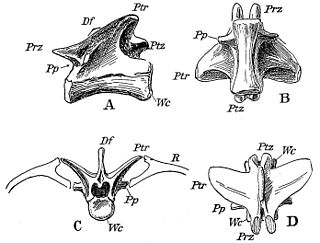
Pterospondylus is a dubious genus of theropod dinosaur from the Late Triassic. It was a coelophysid theropod which lived in what is now Germany. The type species, Pterospondylus trielbae,, was described by Jaekel in 1913–14 for a single back vertebra found inside the shell of the Proganochelys turtle. Sometimes, it is aligned with Procompsognathus, or even considered to be synonymous with it, despite being based on a vertebra that is twice the size of the corresponding bone in Procompsognathus. P. trielbae has no diagnostic features and is therefore considered a nomen dubium.

Terrestrisuchus is an extinct genus of very small early crocodylomorph that was about 76 centimetres (30 in) long. Fossils have been found in Wales and Southern England and date from near the very end of the Late Triassic during the Rhaetian, and it is known by type and only known species T. gracilis. Terrestrisuchus was a long-legged, active predator that lived entirely on land, unlike modern crocodilians. It inhabited a chain of tropical, low-lying islands that made up southern Britain, along with similarly small-sized dinosaurs and abundant rhynchocephalians. Numerous fossils of Terrestrisuchus are known from fissures in limestone karst which made up the islands it lived on, which formed caverns and sinkholes that preserved the remains of Terrestrisuchus and other island-living reptiles.

Saurosuchus is an extinct genus of large loricatan pseudosuchian archosaurs that lived in South America during the Late Triassic period. It was a heavy, ground-dwelling, quadrupedal carnivore, likely being the apex predator in the Ischigualasto Formation.
Lophostropheus is an extinct genus of coelophysoid theropod dinosaur that lived approximately 205.6 to 196.5 million years ago during the boundary between the Late Triassic Period and the Early Jurassic Period, in what is now Normandy, France. Lophostropheus is one of the few dinosaurs that may have survived the Triassic–Jurassic extinction event.
Stagonosuchus is an extinct genus of loricatan, or possibly a species of Prestosuchus. Fossils have been found from the Late Triassic Manda Formation in Tanzania that are Anisian in age.
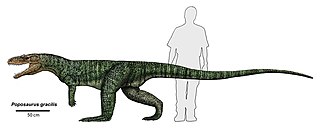
Poposauroidea is a clade of advanced pseudosuchians. It includes poposaurids, shuvosaurids, ctenosauriscids, and other unusual pseudosuchians such as Qianosuchus and Lotosaurus. It excludes most large predatory quadrupedal "rauisuchians" such as rauisuchids and "prestosuchids". Those reptiles are now allied with crocodylomorphs in a clade known as Loricata, which is the sister taxon to the poposauroids in the clade Paracrocodylomorpha. Although it was first formally defined in 2007, the name "Poposauroidea" has been used for many years. The group has been referred to as Poposauridae by some authors, although this name is often used more narrowly to refer to the family that includes Poposaurus and its close relatives.
Apatosuchus is an extinct genus of non-crocodylomorph loricatan pseudosuchian known from the Late Triassic of Germany. It is known from a partial holotype skull from the middle Stubensandstein in Baden-Württemberg. The type species is Halticosaurus orbitoangulatus.A. orbitoangulatus was first described by German paleontologist Friedrich von Huene in 1932, who considered it a species of the theropod dinosaur Halticosaurus. Some later studies proposed that it was an early crocodylomorph or "sphenosuchian" like Saltoposuchus, another pseudosuchian from the middle Stubensandstein of Baden-Württemberg. The name Apatosuchus, "deceptive crocodile", was erected for H. orbitoangulatus by Hans-Dieter Sues and Rainer R. Schoch in 2013 when it was realized that the known material represented a pseudosuchian archosaur rather than a dinosaur, as a result of further preparation of the specimen, coining the combinatio novaApatosuchus orbitoangulatus. Apatosuchus is now thought to be a basal member of the clade Loricata. Apatosuchus is much smaller in size than other basal loricatans such as Teratosaurus and Batrachotomus.



























